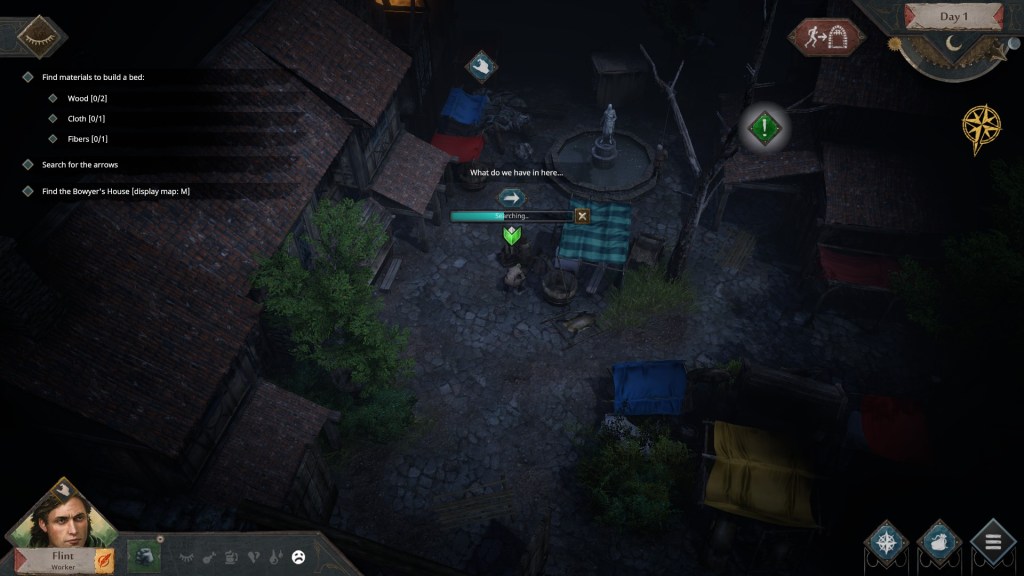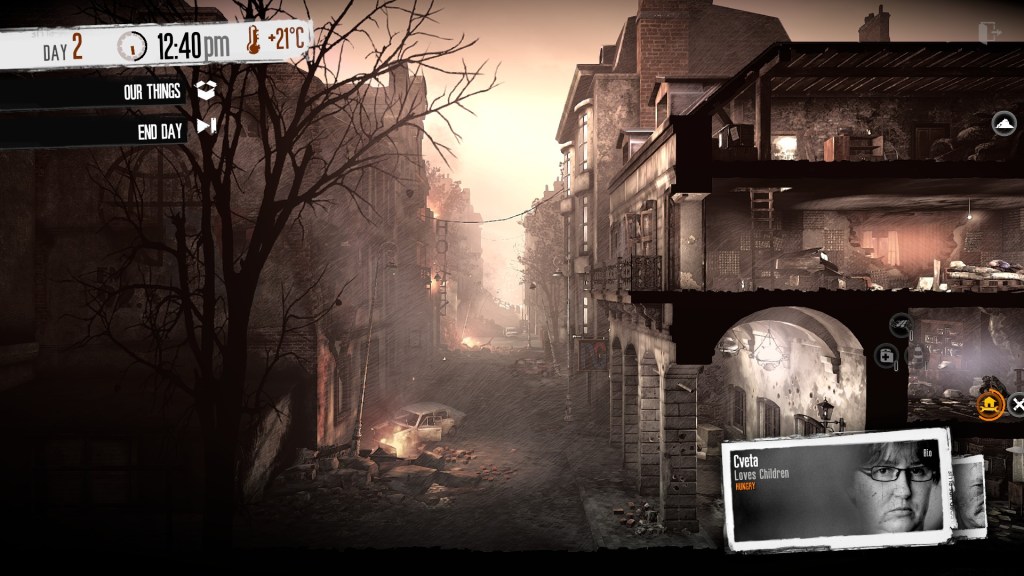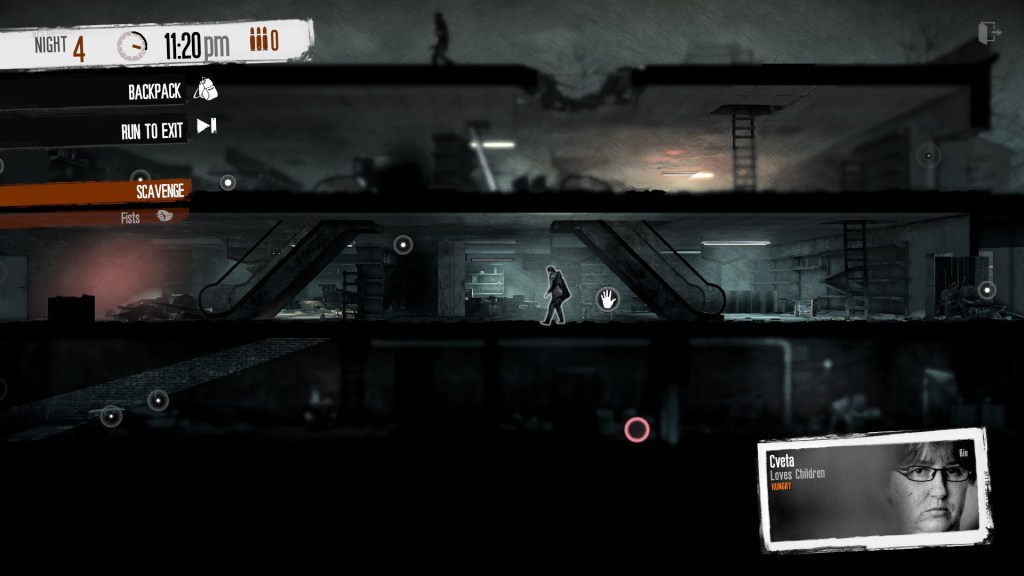Siege Survival: Gloria Victis is a 2021 survival and base-building game from Black Eye Games. Set in the universe of Gloria Victis, an online medieval MMORPG from 2016, Siege Survival follows the citizens of Edring as they are besieged by a foreign army. The game has you sneak out into the city and scavenge resources, which you use to create food and water and also weapons for the soldiers on the wall. It’s This War of Mine, but set during a medieval siege. I love games like this – whenever a title pitches itself as ‘existing game plus X’, it’s always really lush ground for analysis. When one game is intentionally built around another, you can get a really nuanced view of their differences, or of what makes one good and the other great. Siege Survival really scratches that itch – it illustrates, very clearly, the nature of the city in This War of Mine.
So I should say up front that a lot of this is probably going to sound like criticism of Siege Survival – and it’s really not. I personally enjoyed Siege Survival a lot more. I got more out of playing it. It’s maybe not as good as This War of Mine, but This War is a miserable game where you have nothing and get forced into doing terrible things to survive. You only ever feel bad playing that game – and as much as I appreciate its power to generate negative feelings, I also consequently don’t want to play it. However, This War of Mine does have a lot to say about the modern city, exploring those ideas within the context of a city under siege. Siege Survival also features a city under siege, but it doesn’t have anything super deep to say, and it doesn’t have much about the general idea of place – it’s kinda just a scrounging simulator. We can actually map out the changes made by Siege Survival and see really clearly how they remove most of the commentary offered by This War of Mine. In a way, we’re really rehearsing a conversation from a few weeks ago, where we talked about video game criticism as a form. I basically just said that, you know, as critics we want to be careful about how we apply the ‘ought’. The point here isn’t that Siege Survival ought to be more like This War of Mine – it’s not bad for being different. But it’s valuable to understand how TWoM is made, how it achieves its effects, and how the changes made by Siege Survival take most of those effects away.

Let’s start by scoping out the similarities. Both games are obviously about living in a city under siege. They are also built around a system of two halves. During the day, you hide in a safe location, and cook and craft and tend to your wounds. Then during the night you send someone scavenging. You get to run around the city and search for resources and avoid enemy soldiers or dangerous looters. The two halves of the game feed into each other – during the day you make decisions about what resources you need, and how to prioritize your next trip, and during the night you make decisions about which risks are worthwhile, or recalibrate your priorities based on what you actually find. There’s a really tight momentum, as each half pushes forward into the next – you’re always thinking about how your choices affect what you do in the next cycle.
Probably the first major difference, then, is the context that the two games were released into. This War of Mine was published in 2014, during the soaring days of Call of Duty. If you look at the Steam listing for the game, you can still see how it positions itself directly in opposition to the modern shooter:
“In This War Of Mine you do not play as an elite soldier, rather a group of civilians trying to survive in a besieged city; struggling with lack of food, medicine and constant danger from snipers and hostile scavengers. The game provides an experience of war seen from an entirely new angle.”
The game positions itself in the negative, as against what already exists – you’re not what you might expect, you’re not an elite soldier. And again with the closing lines – it’s pitched as a new angle on warfare, as something different to what we’re used to. The game’s original trailer continues this comparison – it opens scrolling past a group of armed men copy-pasted straight out of Modern Warfare, and they do shooting and explosions and so on, and then the camera pans through to a bunch of terrified civilians cowering in a bombed-out home nearby. The soldiers are blasting along down the street, and this woman is holding a (dead?) man in her arms, sobbing, and this dumb kid who’s too young to know what’s going on is just standing there – ugh, I hate this game. A teaser line comes up – “In war, not everyone is a soldier” – and the shooting continues outside.

In that sense, TWoM was a really conscious response to the cultural context of video games in the 2010s. Where Call of Duty glorified American military involvement in the Middle East, This War of Mine reminded us that war isn’t fun. It had something to say – not only about the horrors of warfare, but about the video game industry sucking on the military establishment’s nuts. Siege Survival doesn’t have any of that. It’s set in a medieval city, so there’s no topical relevance to current events, and there isn’t really any commentary on the state of the video game industry either. Medieval sieges don’t have a chokehold on the year’s top ten bestsellers list. Maybe you could argue that it’s a clever response to Dragon Age – I dunno, I never played those games.
This War of Mine also has a lot to say about the nature of the city, and about the specific horror of societal collapse in the modern day. We’ve talked before about James Suzman’s Work – Suzman notes that our global civilization is built around labour that is surplus to what we need to make food. We need a certain number of labourers to work the farms and milk the cows, and if we’re efficient enough with our agriculture practices, we can spare some people to do other things. And we’ve obviously had a bunch of spare labour for a very long time, and we’ve built up this really complex societal infrastructure. I mean, for my job, I work with psychology researchers to translate their research into professional development training for clinicians and health care professionals. Specifically, I manage the online platform where those professionals come to do their professional development, as well as running the production line for any new training that we build. That’s so far removed from agriculture – when you think about all the surplus labour involved, all the stuff that had to be invented to make that job exist – it’s so mind-boggling as to almost feel precarious. Is it safe to be so far removed? That’s the anxiety that This War of Mine plays on.

The complexity of our social structure means that it’s also really, really fragile. This War of Mine reminds us that if our social systems collapse (or even if they violently wobble), we’re so removed from the production of those basic human necessities that we might not be able to re-establish them on our own. What do you do when the taps in your house stop working? What do you do when the supermarket shuts down? One of the early locations you can raid in This War of Mine is actually a local supermarket – other scavengers are there (obviously, it’s a great location), and there’s something really surreal and horrific about jointly looting the place. It’s part of the wreckage of how society used to work – it’s infrastructure that no longer exists. You grab what you can, because nothing more is coming. The lights are out, the checkouts are closed, and once it’s empty, that’s it. You can go home and starve.
Siege Survival, however, as a game set in the medieval period, doesn’t have that sense of alienation. There’s none of the heady infrastructure of the modern day – the technology just isn’t that advanced. Most people are still living in brutish, muddy conditions, raising pigs and hoping that the harvest will see them through. When you move into a state of siege, some infrastructure obviously collapses, but society isn’t as complex – you really don’t lose that much. There certainly isn’t anything comparable to the supermarket scene in This War of Mine. Even the jobs of different characters speak to this divide. In This War of Mine, you get survivors like Pavle the football player, or Anton the math professor. In Siege Survival, characters are more in the vein of Mikel, who works in the stables. When you set Mikel to manual labour, to chopping firewood or feeding the chickens, you never feel like he’s that far out of his element. There’s no comparison to, say, having Pavle the footballer boarding up holes in your house so that raiders don’t break in and steal from you during the night.

I’m aware we’re running a bit longer than usual, so I’ll skate over some of the other differences. In Siege Survival, you move through the city streets, scavenging from stuff that’s been left out in the open. This War of Mine, by contrast, deals mostly in interiors. You’re not roaming the streets – you’re breaking into people’s houses (abandoned or otherwise). There’s a much stronger sense of violation, as you potentially scale up to armed robbery and murder. Siege Survival also presents you with an interconnected city, where it’s all just one big map and you can unlock shortcuts from one side to the other. This War of Mine, alternately, deals in atomized spaces, where each trip takes you to one specific building in one specific area. This again gestures towards the atomization of the modern city – spaces in this game don’t have a shared collective fabric. They exist as pods, as nodes, as isolated units. They are a symptom of the modern age, each place disconnected from its neighbour just as you are disconnected from the people around you.
That sense of disconnect actually deserves more attention – after playing Siege Survival, I reinstalled This War of Mine, and one of the things I found most shocking was how there was no meaningful distinction between violent soldiers and violent scavengers. Siege Survival has a very clear moral compass, divided along national lines. The defenders all pull together, and the invaders are all bad. As you stalk around the city of Siege Survival, the only people you’ll meet on the streets (with a couple of minor exceptions) are guards from the invading army. And you can bop them with your axe and steal their shit, and you’ll see more guards in that area on future nights, but you’re also being a badass. You’re doing guerilla warfare, chipping away at the invading army and sending their weapons and armour to the citadel’s defence. In This War of Mine, there’s such a brutal emotional kick to the conflict. In many instances, you’ll encounter other refugees – just people like you, fellow citizens, who are equally desperate to survive. Sometimes they’ll fight you. I broke into one group’s hideout and was busy ransacking their shelves, and then one of them found me and they all went nuts. I’d broken into their home, their shelter – they were justified in being mad at me. I’d contributed to their sense of dislocation, their sense of vulnerability – all of the things that I was experiencing. I felt awful. Then, when I got home, I found someone had broken in and stolen all our food. They’d also stabbed my math teacher – apparently you’re not meant to leave him as a guard?

While you can come across enemy soldiers in This War of Mine, the real moral heart of the game is in how you treat your fellow citizens. For those of us who live in cities, we already experience alienation from the people around us in our day to day lives. I can be on a busy train stuffed full of wet, sniffling commuters, standing ass-cheek to ass-cheek with some stranger, knowing that we’ll both walk off into the rain and never see each other again. We are already distant in our proximity. The question is how that distance translates after society’s collapse. Do we further alienate our fellow citizens? Do we rob them or murder them? Do we starve and die in the noble (stupid) name of respecting their property rights? Siege Survival doesn’t care about any of that. You only fight guards from the invading force. You only gather resources from wood piles or rubble in the street – not from any other survivor’s personal stockpile. And you’re still fundamentally plugged into the function of the city, as you use your resources to create food and weaponry not just for yourself, but also for the castle’s defenders.
Where This War of Mine was all about your disempowerment, your disconnect from the geopolitical conflict playing out around you, Siege Survival sets you up as a fundamental part of the war effort. Each day, you have to send food and supplies to the bastion. If you fail to offer enough support, the defence collapses, the city falls, and you lose the game. If your scavenging is good enough, you can build up enough of a defence to keep the army at bay until your guys turn up and end the siege. This really is the biggest philosophical shift between TWoM and Siege Survival – in This War, you don’t matter; in Siege Survival, you really do. I think again this speaks to the relative settings – in the big city, it’s so easy to feel like you don’t matter. You are just one person against a backdrop of millions. Your actions in TWoM do absolutely nothing to lengthen or shorten the war, because you are just some hapless shmuck caught in the middle. You don’t matter, the game says. How do you want to act? Siege Survival, by contrast, emphasises at every turn the interconnectedness of your environment. The map all hooks up, and you know the survivors you encounter – when you find Gerard, you’re told you “recognise” this “well-known butcher.” When you find Jacob, it’s another spark of recognition: “that’s Jacob, the old scribe serving the city guard!” Kimbra is “an innkeeper you know well,” and Rose is “the miller from a nearby village, who used to come to Edring every week to sell flour. She recognises you too.” The game’s sense of empowerment and hope arguably stems from that interconnectedness – from the knowledge that no matter how bad things are, you’re still all part of the same social fabric, working together towards mutually beneficial goals. Sure, the city’s under siege, but if you feed your pigs and forge some swords, you’ll be fine. You’ll all be fine together. Really that’s the key difference between these games – if This War of Mine is about the nightmare of the modern city, Siege Survival is a dream of a simpler, earlier time.


Great article as always. I recently read The Day of the Triffids. Lots of similar themes: of dislocation of our modern life from agrarian survival skills, the different possible responses when our modern structures fail, the noble stupidity of trying to respect the old social norms in a new world, and the tension of disconnection vs. finding connection in community.
It’s interesting to think about how the enemy is positioned in each of these texts. It sounds like all the texts use common enemies as a way to connect people, but in War the enemy is the gang next door, with all the associated complexity, while Siege places the enemy as simple outsiders, easy villains. In Triffids, it plays with a range of different threats, but ultimately people band together against an alien threat. Interesting to compare how comfortable each text is with using the threat of outsiders to motivate forming communities.
Also, killing Maths teachers – rude!
LikeLiked by 1 person